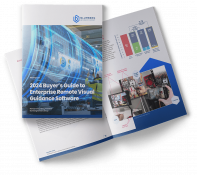Help Lightning Blog
3 Augmented Reality Experiences That Will Disrupt Industries

Increasingly, consumers are either actively seeking out augmented reality experiences (thanks to all the benefits and conveniences they offer), or they are unknowingly partaking in an experience which they will later come to call augmented reality.
Common augmented reality experiences that the average person is likely to have already encountered, if not taken advantage of, include Ikea’s mobile app, the L’Oreal Makeup app, and Nintendo’s Pokemon Go app (for more info on how these work in practice, check out our article on 5 AR companies to watch).
Now, these are all extremely useful, fun manifestations of an industry disrupting idea: layering dynamic, digital elements on top of reality to enhance, expedite, or improve an experience of end result.
But what about some B2B examples of augmented reality? How will these change the face of business over the next 5 years?
Let’s dive into 3 augmented reality experiences that you need to know about going forward, and their implications for each industry.
1. Manufacturing
Computer scientists at the Technical University of Munich in Germany believe that there are seven sectors of the economy which will face the most drastic change thanks to augmented reality experiences:
- Retail
- Music
- Automotive workshops
- Manufacturing
- Communications
- IT services
- Education
Professor Hutzschenreuter, who leads the team at TUM, argues that since “virtual and augmented reality are disruptive technologies,” they will undoubtedly “eliminate existing products, business models, and production processes,” replacing them with more efficient, enhanced alternatives. So when it comes to manufacturing: what augmented reality experience could be most helpful to the industry?
Well, look no further than the prototyping part of the manufacturing process. According to Clickz, augmented reality will provide an excellent solution for more easily spotting manufacturing errors. By digitizing product prototyping in 3D, even remote team members and other experts will be able to collaborate within AR to eliminate mistakes, and speed up the process to final product approval.
2. Healthcare
The healthcare industry has no shortage of AR experiences to leverage.
For instance, Help Lightning’s AR-powered software helps doctors and healthcare providers:
- interface with remote patients,
- more efficiently and easily train employees,
- learn to use complex medical equipment, and
- connect with experts to fix any problems with aforementioned equipment.
Help Lightning’s augmented reality experiences involve the use of digital elements, highlighted by the company’s merged reality. This feature allows an expert to use hand gestures that will show up in the view of a customer needing help. It also includes the ability to annotate on screen, screenshot certain images, freeze frames so as to point out specific problems, and video record conversations. The aim here is that lines of communication are opened, miscommunications and errors are reduced, and remote care/learning is made more accurate, accessible, and cost effective. (Dive into this article to learn how medical technology company Becton Dickinson leveraged Help Lightning to deliver remote customer support in a medical setting).
Another augmented reality experience within this industry would be medical imaging. Specifically, this would involve enhancing visualization of CT or MRI data by adding projections during a surgical procedure. Needless to say, a 3D visualization of a patient’s anatomy, in addition to data gleaned from other processes and procedures, available in one view would impact how surgeries are performed and their timing, too.
3. Education
We may think of museums as somewhat traditional places, reserved for protecting and illuminating the past. But when it comes to augmented reality, they’re diving into the future when it comes to this technology.
Here are some more straightforward augmented reality experiences on offer at museums:
- Adding a third, digital dimension to exhibits and displays
- E.g. adding dates, pictures of artists, and other helpful information next to pieces of art to enhance visitors’ understanding and learning
- Bringing scenes and objects to real life
- Making history and art more dynamic and interactive, AR assistance can literally bring artifacts “to life”
But they’re not stopping there. Museums are also collaborating with AR partners in order to create themed projects:
- In June 2021, the Museum National d’Histoire Naturelle in Paris launched ‘REVIVRE’ with the help of Microfost’s Hololens. It lets visitors see, meet, and interact with digital animals which are now extinct.
- Similarly, in 2021, the National Gallery in London used AR outside of their own building to engage the public. Certain collections, such as the National Portrait Gallery, and the Royal Academy of Arts, allowed users to access these works of art through their phones. The QR codes were located on busy streets in central London.
Here’s a video to show exactly what this looked like in practice:
- The National Museum of Singapore went one step further, creating an augmented reality experience which acted as a sort of educational “treasure hunt” earlier this year. With an installation called Story of the Forest, visitors work to ‘catch’ three dimensional artifacts and animals, learning fun facts about them as they go.
Augmented Reality Experiences: Summary
To wrap up, it’s clear that augmented reality experiences can span a number of use cases. Whatever form they take, they can be incredibly positive in facilitating learning, onboarding, training, customer service, and way more. We recommend your business begins tapping into the benefits AR offers. Live remote assistance will give you a leg up on competitors and differentiate yourself in your industry early on.
Interested in the benefits Help Lightning could offer your business? Grab a no cost, no obligation product demo.












